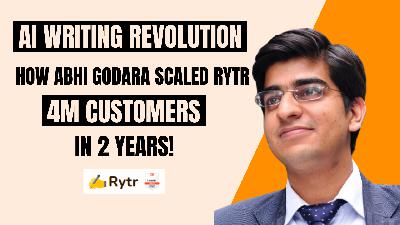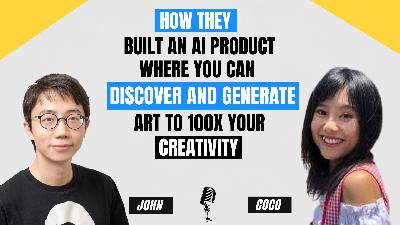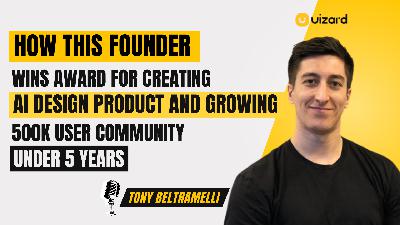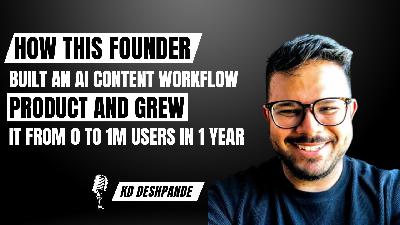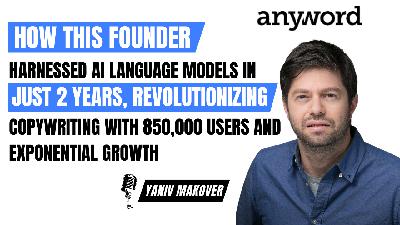This founder built a platform to create lifelike characters for immersive experiences | EXCLUSIVE!
Description
Kylan Gibbs is the CPO and Co-Founder at Inworld AI. He is the former Product Manager at DeepMind, Consultant at Bain and also Co-founder at FlowX. In today's episode, Kylan Gibbs shares his experience working in AI startups and consulting, as well as his time at DeepMind working on conversational AI and generative models. He emphasizes the importance of iterative processes, adapting to market pressures and user feedback, and the need for creativity in defining good content in the AI space. He advises aspiring product creators to focus on building something that validates their value rather than teaching others before learning. Tune in to hear Kylan's insights and experiences in building Inworld AI and how you can apply these lessons to your own product.
Find the full transcript at: https://www.aiproductcreators.com/
Where to find Kylan Gibbs:
• LinkedIn: https://www.linkedin.com/in/kylangibbs
Where to find Dhaval:
• LinkedIn: https://www.linkedin.com/in/dhavalbhatt
Transcript:-
Dhaval: This founder and his team built a platform to create life-like characters for immersive experiences like games or books. In this show, Kylan Gibbs shares his thoughts on generative AI and how to manage products where you create immersive experiences. He also discusses his career journey. Kylen is a former product manager at DeepMind. He was also a consultant at And a co-founder at Flow X. Now he's a C P O and co-founder at In World AI.
Hey Kylan, welcome to the show. Tell us about where you are in your product journey, a little bit about your product as well.
Kylan: Awesome. Yeah. Thank you so much for having me. Super excited to be here. So At InWorld, we're building a creative suite of tools that allow people to build these AI characters and then integrate them into immersive experiences, games, entertainment, enterprise experiences as well. And we started just over a year and a half ago. And basically where we're at now is we have this studio where people can come in and actually craft their characters. We got integrations with things like Unity, unreal, where they can bring them into games, as well as Node for actually bringing these into web experiences. We've also then got sort of this arcade and, basically, which is a way to actually share these characters directly to the web. And then a suite of experiences that we're gonna be releasing this year that are self-produced. So we've got, for example, in world origins to sort of show off the power of the product. And this is all to sort of say that this is kind of crafting that end-to-end user journey of being able to build these characters and then bring them into worlds. And basically where this has all been going is kind of setting the foundations of actually being able to not just create the characters, but, build them into experiences and deploy them scalably. And I think, compared to a lot of the things you're seeing in generative AI right now, like it really is production ready. And we've been focused on that. And so we've already seen a lot of developers starting to churn out games and experiences now that are integrating in world characters. So it's super exciting to kind of see that. So, of course still early on, I'm excited to see where it goes, but already seeing hundreds and thousands of users using it, plus, actually seeing live experiences is pretty magical.
Dhaval: Wow. There's a lot there. So let me just quickly ask you a follow-up question on how you support game creators. Is that right? Or do you support all kinds of creators, like writers, novelists, or just focus on gaming experiences at this?
Kylan: We're supporting really any type of creator. So ultimately, we have users who are, for example, very, well-known science fiction authors who are using their characters to iterate on experiences and potentially write new books with, we have people actually building like AAA games and these types of experiences where you're building multiple characters and integrating them into worlds. We have entertainment companies who, you imagine integrating these into parks or like live experiences where you're actually interacting with. And then we also have enterprises who are using these for things like, brand representation, corporate training. So really we're open to any types of creators. Of course, we're really focused on narrative oriented, immersive experiences, and our product is best built for that. So, you know games, narrative, entertainment, you can think about the adaptation of movies and IP to these experiences. And that's really what we're targeting. But we're really open to any types of creators, and we're finding new ones every day.
Dhaval: Yeah, I picked up a keyword there. Narrative oriented, immersive experiences that could be representing multiple customer segments. What is your product journey like? How do you go about defining your product capabilities with such a broad range, range that you know you could be?
Kylan: I think that, so abstracting out of our specific use case for a second, like I think when you're building a developer tool, you always have two customers. You have to think, keep in mind, one is your creators, your developers, and the other is your end users. And so for us, our creator journey is really people coming in. They have ideas either their building an existing experience or they're ideating on a new one and they're using the studio and our characters to basically iterate on that and then integrate it through things like Unity and Unreal to actually bring those to users. And so when we think about success in that, it's basically: is this person able to create the character that they love and like, and kinda ultimately represents the vision that they have and fulfills the purpose? And then are they able to integrate that and deploy that successfully. Then you have the actual end users, which are the people actually interacting with the characters that the developers built. And that is really like, is the interaction enjoyable? Is the person you know staying around to talk with this character? Are they finding out what they need to progress through this experience? You can imagine throughout a game you have someone that's a guide or shopkeeper and they have to fulfill a particular role. Are they doing that successfully? And so you really have to balance the two of those. I think that's true for most developer tools, but it's kind of unique here because, ultimately there's a key part here, which is like, it's the generated content. So it's almost like we are allowing developers to create characters that are fulfilling the wants that they have for the users in the end? And so it's always a little bit of an art and a science.
Dhaval: Yeah, there is a lot of art there, especially when it comes. The narrative, the experience, right? The character creation and then narrative and the experience. What are some of the ways you create these characters that actually immerse themselves and are conducive to the experience? Is there a difference in product creation? How do you actually adapt to the narrative or the experience that the creator is trying to have?
Kylan: Yeah, I guess there's two points, which is like design time and run time here. So at design time, you could take for example, Arah LA a large language model and generate sort of responses that are aligned with a particular character. But getting them to do that reliably and stick to a story and actually fulfill goals and actions is very difficult. So we actually allow users to come in and they can specify, for example, scenes for their story, and then the characters will actually stick to basically, the kind of motivations and goals that they have for that specific scene. Then we allow them to specify, what is this character supposed to accomplish in this? How are they supposed to speak? What types of things in the world might they be reacting to? And all of that sort of is going towards controlling and biasing the character behavior in a specific moment within a specific story. So they're fulfilling what they're supposed to. And that's all kind of the design side. When you're actually interacting with the character. Then we introduce, for example, emotions. So the characters actually react with emotionality. We have voices that also integrate that emotionality, so the characters can actually, you know, you could hear when you upset a character, for example, and you can react to that. We then control gestures and animations. The characters can actually react to you, or you can ask them to perform a particular action and they can actually act on that. And so, that ability to actually have, and we'll be releasing this soon, and we have a new system where you can actually, for example, give a character a goal and a series of actions that they can use to pursue that goal. And they'll autonomously pursue the goal until they've accomplished it, which is like a pretty magical thing if you think about the ability to actually create this living thing that's kind of, pursuing goals and motivations. But of course all of that comes back to the ability to actually drive this story or narrative forward, whether it's something like Assassins Creed or Far Cry or one of these games. Or you can think about








